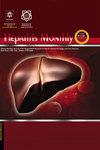Hepatitis C Treatment Among People Who Use Drugs in an Office-Based Opioid Treatment Program Versus a Syringe Exchange Program: A Real-World Prospective Clinical Trial
IF 0.6
4区 医学
Q4 GASTROENTEROLOGY & HEPATOLOGY
引用次数: 0
Abstract
Background: Hepatitis C Virus (HCV) treatment in people who inject drugs (PWID) is a key component of elimination models but PWID face substantial barriers to treatment access. Despite data showing treatment outcomes among PWID on medications for opioid use disorder (MOUD) are similar to non-PWID outcomes, few studies examine PWID treatment outcomes with only syringe services support. Objectives: To evaluate the effect of recruitment for HCV treatment with elbasvir/grazoprevir (E/G) in a syringe services program (SSP) as compared to an MOUD program for people with opioid use disorder. Methods: This real-world, multi-site prospective open-label pilot study compares treatment of PWID with aspartate aminotransferase to platelet ratio (APRI) < 0.7 and genotype 1a, 1b, and 4 HCV with E/G, engaged in MOUD (n = 25) or an SSP (n = 25). The MOUD arm was enrolled through a federally qualified community health center and SSP arm through a nearby SSP. Prospective arms were compared to an academic hepatology clinic group (n = 50). Sustained virologic response at 12 weeks (SVR12), medication adherence, and treatment discontinuation were evaluated. Results: In the MOUD vs SSP arms, substance use throughout treatment was found in 36% (9/25) vs 100% (25/25); good adherence (> 90% pills taken) in 100% (25/25) vs 68% (17/25); treatment completion 100% (25/25) vs 64% (16/25); and SVR12 rates were 96% (24/25) vs 60% (15/25). In the community standard comparison group, SVR12 was achieved in 94% (47/50). There were two virologic failures or re-infections in the SSP group; all other non-responders were due to missing SVR12 data. Conclusions: While recruitment and follow-up are challenging in SSPs, preliminary data suggests adherence, treatment completion, and SVR12 are high in PWID treated with E/G engaging in SSP or MOUD. All metrics are comparable to community standards for non-PWID for treatment of HCV with direct-antiviral drugs.在办公室阿片类药物治疗项目与注射器交换项目中使用药物的人群中的丙型肝炎治疗:一项真实世界的前瞻性临床试验
背景:注射吸毒者(PWID)的丙型肝炎病毒(HCV)治疗是消除模式的关键组成部分,但PWID在获得治疗方面面临重大障碍。尽管数据显示PWID患者使用阿片类药物使用障碍(mod)的治疗结果与非PWID患者的治疗结果相似,但很少有研究调查仅使用注射器服务支持的PWID治疗结果。目的:评估在注射器服务计划(SSP)中使用elbasvir/grazoprevir (E/G)治疗HCV的招募效果,并与阿片类药物使用障碍患者的mod计划进行比较。方法:这项现实世界的、多地点的前瞻性开放标签试点研究比较了天冬氨酸转氨酶与血小板比率(APRI) < 0.7和基因型1a、1b和4型HCV合并E/G、mod (n = 25)或SSP (n = 25)的PWID治疗。mod组是通过联邦认证的社区卫生中心注册的,而SSP组是通过附近的SSP注册的。前瞻性组与学术肝病临床组(n = 50)进行比较。评估12周时的持续病毒学反应(SVR12)、药物依从性和停药情况。结果:在mod组和SSP组中,整个治疗过程中药物使用的比例分别为36%(9/25)和100% (25/25);良好的依从性(100% (25/25)vs 68% (17/25);治疗完成率100% (25/25)vs 64% (16/25);SVR12率分别为96%(24/25)和60%(15/25)。在社区标准对照组中,94%(47/50)达到了SVR12。SSP组有2例病毒学失败或再感染;其他无应答者均为SVR12数据缺失所致。结论:虽然SSP的招募和随访具有挑战性,但初步数据表明,在E/G参与SSP或mod治疗的PWID中,依从性、治疗完成度和SVR12很高。所有指标均与直接抗病毒药物治疗丙型肝炎的非pwid社区标准相当。
本文章由计算机程序翻译,如有差异,请以英文原文为准。
求助全文
约1分钟内获得全文
求助全文
来源期刊

Hepatitis Monthly
医学-胃肠肝病学
CiteScore
1.50
自引率
0.00%
发文量
31
审稿时长
3 months
期刊介绍:
Hepatitis Monthly is a clinical journal which is informative to all practitioners like gastroenterologists, hepatologists and infectious disease specialists and internists. This authoritative clinical journal was founded by Professor Seyed-Moayed Alavian in 2002. The Journal context is devoted to the particular compilation of the latest worldwide and interdisciplinary approach and findings including original manuscripts, meta-analyses and reviews, health economic papers, debates and consensus statements of the clinical relevance of hepatological field especially liver diseases. In addition, consensus evidential reports not only highlight the new observations, original research, and results accompanied by innovative treatments and all the other relevant topics but also include highlighting disease mechanisms or important clinical observations and letters on articles published in the journal.
 求助内容:
求助内容: 应助结果提醒方式:
应助结果提醒方式:


